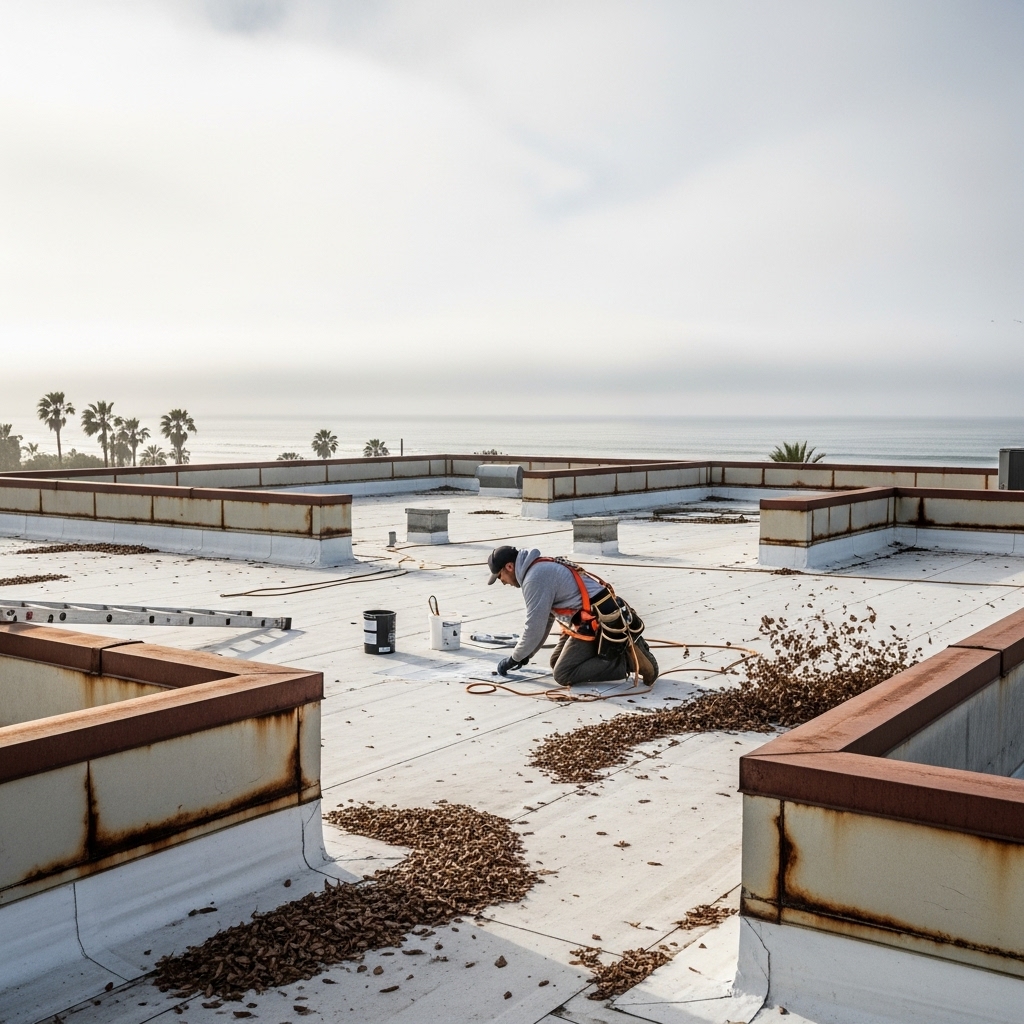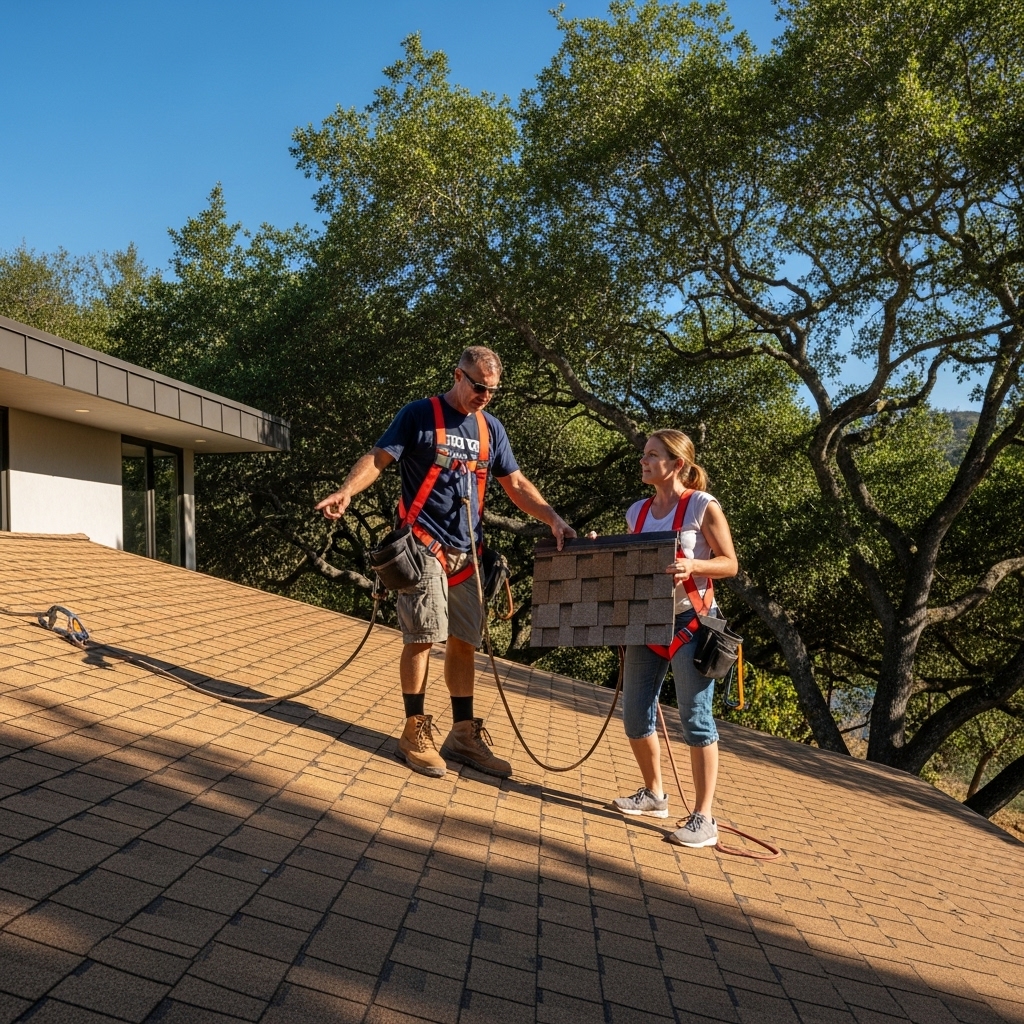When you live and work in Oxnard, you get used to the rhythm of the coast. Mornings can start with a cool marine layer, afternoons warm up with sun and a steady breeze, and every so often a Santa Ana wind pushes through with a dry intensity that reminds you why local building practices matter. Those conditions are exactly why understanding how flat roofing repairs are scoped and why the final investment varies is so important here. In this guide, I will walk you through the variables that influence repair decisions on low-slope systems around the Oxnard plain, from material type to access and weather windows, so you can talk with confidence when it is time to schedule service on your building’s roof. If you’re just beginning to explore your options, it helps to start with a baseline of what flat roofing entails in our coastal environment and how professionals think through a repair.
Oxnard’s mix of sea air, sun exposure, and occasional high-wind events is friendly to some roofing systems and more punishing to others. Thermoplastic membranes like TPO and PVC are popular because they reflect heat and can handle coastal UV, but their seams and flashing details need expert attention over time. Older buildings might still have built-up roofing or modified bitumen, each with its own aging pattern and repair approach. Understanding what your roof is made of is the first step in understanding why a repair near one curb could be straightforward while resolving a seam opening across a large field might be more involved. Different materials call for different primers, patching compounds, and techniques, and the right pairing of method to membrane is a major driver of a successful, lasting repair.
Before any repair conversation turns practical, a thorough assessment sets the stage. In our area, that usually includes a visual walk-through, a focus on past trouble spots, and moisture detection—either with noninvasive meters or, when needed, core sampling to confirm what is happening below the membrane. On a coastal roof, trapped moisture can hide longer because morning condensation mingles with prior leaks, so a technician who knows Oxnard will time inspections to get a clear reading after the deck has had a chance to dry. When water is present in the insulation, a small patch is rarely the full answer; the saturated section may need to be removed and replaced so you do not lock moisture in where it can degrade the substrate and reduce energy performance.
Access is another factor that people underestimate until the day of work. Many commercial properties around Oxnard Boulevard and Rice Avenue have rooftop equipment clustered tightly, which makes staging and maneuvering challenging. If a crew needs to move carefully around solar arrays, multiple HVAC units, or a dense landscape of conduits, the repair steps take longer. Buildings closer to the coast might also have stricter local noise and access windows, and some facilities require escorts or sign-ins that add to the time on site. Even something as simple as where a ladder can be safely tied off or whether a small lift is needed from the alley can influence the overall plan.
Flashing and edge details deserve special attention near the ocean. Salt in the air accelerates corrosion on metal terminations, fasteners, and equipment curbs. A membrane patch will not mean much if a rusted counterflashing is moving or a coping joint is opening up under wind uplift. In practice, a complete repair often bundles work at these transitions: tightening or replacing fasteners, addressing rust, renewing sealant, and ensuring the membrane is properly attached to the parapet or curb. These are not cosmetic touches; they are core to keeping wind and water out, especially during those blustery afternoons when gusts work on any weak edge like a pry bar.
Drainage shapes both the need for repair and the steps taken. Oxnard roofs see long runs of light mist and then bursts of rain. If drains, scuppers, and gutters are partially blocked with eucalyptus leaves or roofing granules, water can pond in shallow areas, testing seams and magnifying small defects. A responsible repair plan typically includes restoring drainage paths. That might mean clearing debris, resetting a drain bowl, or reinforcing low spots where the membrane has settled over time. If your roof has a history of ponding, the repair conversation should include how to prevent water from lingering again; otherwise, you are just chasing symptoms.
Consider also how building usage shapes the timeline. Food processing and cold-storage facilities around the Oxnard industrial park, for instance, often run on tight production schedules. Repairs that require adhesives or primers with odors may need to be planned around intake systems or off-hours to avoid impacting indoor air. Medical offices or schools have their own scheduling realities. When we talk about the scale of a repair here, we are not only talking about the square footage of material but the sequencing that keeps your operations uninterrupted while work proceeds safely.
Many owners ask if one leak means a small fix or a wider restoration. The honest answer is that it depends on the condition of the membrane and insulation beyond the leak point. If seams across the roof remain sound and the problem is isolated—say a puncture near a service walkway—then the repair tends to be focused and efficient. If, however, several areas show heat-related shrinkage, or if earlier patches are failing, then the smartest move is a targeted repair that also reinforces known weak lines. In some cases, the middle ground is best: address the immediate leak and take preventive steps across similar stress points so the same failure does not pop up elsewhere after the next storm.
Oxnard’s climate pushes materials in different ways across the year. The marine layer cools and introduces moisture early in the day, then sun warms the membrane, and the daily thermal cycle repeats. Over time, that movement can open seams, fatigue flashing at corners, and stress sealants. Repairs that follow manufacturer best practices—proper surface prep, compatible primers, rolled-in patches with correct overlap, and heat-welds where required—stand up far better. Alongside technique, documentation matters. Photographs before and after, a map of the areas addressed, and notes on materials used help keep warranties intact and guide future technicians who may work on the roof.
There is also the question of inspections and code. In Ventura County, permits may be required for larger scopes or when replacing structural components. While a small patch does not trigger an inspection, repairs that involve removing wet insulation or addressing deck damage often do. A local pro will advise when to bring the city into the loop and how to schedule around weather. Planning inspections carefully ensures that openings are not exposed longer than necessary and that all stakeholders are aligned on what will be done, when, and how.
In the middle of all these considerations is the craft of leak tracing. In Oxnard, wind-driven rain can enter at one point, migrate along a fastener row or a flute in the deck, and appear in the interior dozens of feet away. Because of that, pinpointing the path takes experience. Infrared scans after a sunny afternoon can reveal subsurface moisture, and selective water testing can confirm suspicions without soaking the building. The best repairs come from pairing diagnostic precision with disciplined execution, which is where seasoned flat roofing professionals make a difference. They know how the local weather pushes water, how our coastal environment ages materials, and how to stage the work so that fixes last.
Owners sometimes wonder about temporary versus permanent fixes. A temporary dry-in can be appropriate if rain is imminent and a full repair would leave the roof vulnerable before weather rolls in. The key is to follow up promptly with the permanent solution once the deck and insulation are dry and ready. Leaving a temporary patch in place too long can trap moisture or mask a growing problem. A clear plan, shared in writing, sets expectations and keeps everyone on schedule.
Another often overlooked variable is the roof’s history. If you have maintenance logs, photos, and prior service reports, share them. Patterns emerge: a seam that has opened repeatedly, a drain that silts up every fall, or a curb that moves when equipment cycles on. The more context your contractor has, the more likely they can design a repair that addresses root causes instead of symptoms. For example, if forklifts rumble beneath a metal deck and vibration telegraphs up, adding reinforcement at stress points around penetrations can extend the life of the fix.
Safety and site preparation influence every repair in subtle ways. In Oxnard, coastal breezes can shift quickly, which matters when heat-welding membranes or working with adhesives. Crews plan tie-offs, set wind breaks where needed, and keep materials secured so nothing turns into a hazard. Protecting the building is part of that mindset, too. Walk pads, moving blankets, and careful routing keep traffic off sensitive areas, and interior protection—poly sheeting, drip trays—comes out if ceiling leaks are active while a roof is opened up.
For many property managers, the most reassuring part of a repair is the handoff. A good crew will leave you with a clear description of what was done, any conditions that warrant monitoring, and simple steps you can take between service visits. In Oxnard, that usually means keeping drains clear, calling for a check after a major wind event, and ensuring that any vendors who access the roof follow basic care—no sharp tools on the membrane, no dragging equipment, and closing up behind themselves. These small habits can stretch the value of any repair and keep the system performing through our coastal cycles.
Finally, it helps to think of a repair as part of an overall care plan. Pairing corrective work with routine maintenance—seasonal walk-throughs, sealing minor defects before they grow, and documenting all changes—keeps your roof resilient. When you weigh the options, remember that the lowest effort today is not always the most durable tomorrow. The goal is not just to stop a leak but to restore performance in a way that aligns with how your building lives and breathes in Oxnard’s unique climate.
What factors most influence flat roof repair decisions in Oxnard?
Material type, membrane age, and the condition of seams and flashings shape the scope. Local realities—salt air, wind exposure, and drainage patterns—guide how repairs are prioritized. Access, safety requirements, and building use influence scheduling and crew size. A moisture assessment often determines whether work is confined to the surface or includes removing and replacing wet insulation to prevent ongoing damage.
How do you find the true source of a leak when water appears far from the entry point?
Experienced technicians combine visual clues, knowledge of roof construction, and diagnostic tools. Infrared surveys after warm afternoons can reveal subsurface moisture. Selective water testing can confirm pathways without drenching the building. In low-slope systems, water can travel along fastener rows, seams, or deck flutes, so mapping the roof and noting interior drip points is crucial to accurate tracing and effective repairs.
Will repairs interfere with daily operations at my facility?
Most work can be scheduled to minimize disruption. For sites with air intakes or sensitive processes, repairs involving primers or adhesives may be timed for off-hours or with temporary intake adjustments. Clear communication helps coordinate access and safety. Crews protect walkways, manage debris, and provide updates so you can keep staff and tenants informed throughout the process.
What role do drainage and housekeeping play in preventing future leaks?
They are essential in our coastal climate. Consistent removal of leaves and debris from drains and scuppers prevents ponding that stresses seams and low spots. During long misty stretches, even small blockages can hold water against the membrane. Pairing good housekeeping with seasonal inspections allows small issues—like a lifted corner or minor split—to be addressed before they develop into larger leaks.
How should I prepare for a repair visit?
Share any history you have: previous leak locations, photos, and service notes. Confirm roof access and any site-specific safety or escort requirements. If interior protection is needed beneath active leaks, have those areas identified so crews can stage protection quickly. After work, keep the documentation provided; it will help with future maintenance and warranty compliance.
If you are ready to move from uncertainty to a confident plan, partner with local specialists who know Oxnard’s roofs and weather patterns. For thoughtful guidance, clear communication, and craftsmanship that stands up to our coastal conditions, reach out to discuss your building’s needs and schedule a professional evaluation of your flat roofing. The right repair, executed at the right time, can restore performance and peace of mind for seasons to come.






